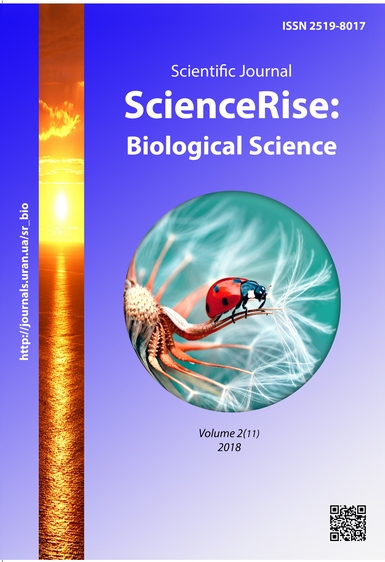Features of seasonal dynamics of biogens content in the superficial waters of vidsichne water intake of Teteriv river
DOI:
https://doi.org/10.15587/2519-8025.2018.129786Keywords:
biogens, phytoplankton, season fluctuations, anthropological euthrophication, water “florescence”, correlation degreeAbstract
Aim of the research – to reveal features of the seasonal dynamics of the biogens content in surface waters of Vidsichne water intake of the river Teteriv in 2012-2014 years and explanation of their correlations with the number of plankton water plants.
Methods. In water samples, taken from water intake (1 dm3), there was determined the content of ammonia, nitrites, nitrates and polyphosphates by photometric methods, for studying the composition of phytoplankton, there was realized the hydrobiological analysis, statistical processing of the data was realized by the program MO Excel 2003.
Research results. The most content of nitrogen oxides in water was observed in spring months as a result of washing nitrogen fertilizers out from soil at overflow, polyphosphates – in winter, when they are not used by phytoplankton. The growth of ammonia concentrations during a year was conditioned by the systematic income of flowing with nitrogen compounds that it was formed of in the water basin. The conducted correlative analysis showed negative weak and middle correlations between the content of separate biogens in water and the number of plankton water plants.
Conclusions.
1. The studies determined that biogens concentrations didn’t exceed MPC s, and their seasonal dynamics was typical for nitrites, nitrates, polyphosphates and not typical for ammonia. The content of this substance in water (in average 0,42 mg/dm3) is more than the natural one (from 0,01 to 0,20 mg/dm3),and features of its fluctuations testified intensification of ammonification processes.
2. It was established, that in 2012-2014 there was observed “florescence” of water mainly at the expanse of blue-green water plants (cianobacteria), which number increased in average in almost 12 times comparing with 2003-2005. At the same time veritable correlations of these water plants with biogens were lost (excluding 2013 year, when the correlation of the nitrates content with the number of blue-green ones was - 0,5780 and green -0,5458, and also the content of nitrites with the number of blue-green ones was at the level of - 0,5743).
3. There was revealed the intensification of correlations of the ammonia content in water with the number of cells of green (-0,6577 in 2012) and diatomaceous (-0,5332 in 2013) water plant and vice versa – the essential weakening of correlations between the content of polyphosphates and representatives of phytoplankton of all sections, especially there took place the decrease of most values of their correlation coefficients with blue-green (from -0,6662 to -0,3255) and green from -0,6118 to -0,3507) water plants.
4. The ground of these disorders in the water basin was the moderate systematic pollution of water by flowing at the background of climatic changes that was proved by ammonification activation and deceleration of nitrification transformation of nitrogen-containing biogens that is by processes that indicate the absence of the proper detoxication of ammonia in the water environment. For preventing the water intake pollution, it is necessary to prevent unapproved water flowing to it
References
- Hriuk, I., Sukhodolska, I. (2012). Vmist spoluk nitrohenu u vodi malykh richok yak pokaznyk rivnia antropohennoho navantazhennia terytorii. Visnyk Lvivskoho universytetu. Seriia biolohichna, 60, 227–238.
- River watch. Manual for public environmental monitoring (2015). Saint Petersburg: Friends of the Baltics. Coalition Clean Baltics, 32.
- Malik, A., Grohmann, E., Akhtar, R. (Eds.) (2014). Environmental Deterioration and Human Health: Natural and anthropogenic determinants Dordrecht: Springer, 2014. P. 8–16. doi: 10.1007/978-94-007-7890-0
- Zapolskyi, A. K., Shumyhai, I. V. (2015). Okhorona pytnykh vod vid vysnazhennia i zabrudnennia. Ahroekolohichnyi zhurnal, 3, 6–15.
- Dudnyk, S. V. (2014). Vodna toksykolohiia. Part 2. Ikhtiotoksykolohiia. Kyiv, 108.
- Kanivets, S., Voronko, L., Chabovska, A., Glybovets, I., Korostin, O., Shyhymaha, I., Shcheglova, A. (2015). Sesonna dynamika vmistu nitrativ u poverkhnevykh і gruntovykh vodakh. Аgroecologichnyi zhurnal, 3, 33–38.
- Bergkemper, V., Weisse, T. (2017). Phytoplankton response to the summer 2015 heat wave – a case study from prealpine Lake Mondsee, Austria. Inland Waters, 7 (1), 88–99. doi: 10.1080/20442041.2017.1294352
- Arystarkhova, Е. О., Shavurska, Т. О., Kupriiets, О. L., Truskavetska, L. М. (2006). Doslidzhennia vplyvu bioheniv na osoblyvosti rosvytku evtrophnykh prozesiv u vodoskhovyshchi Denyshi. Visnyk Zhytomyrs'koho derzhavnoho universitetu, 3 (38), 130–133.
- Van Apeldoorn, M. E., van Egmond, H. P., Speijers, G. J. A., Bakker, G. J. I. (2007). Toxins of cyanobacteria. Molecular Nutrition & Food Research, 51 (1), 7–60. doi: 10.1002/mnfr.200600185
- Pil'kevich, І. А., Arystarkhova, Е. О. (2013). Mathematical modeling of the seasonal changes of phytoplankton growth in the water intake „Vidsichne” of the river Teteriv. Eastern-European Journal of Enterprise Technologies, 3 (4 (63)), 36–39. Available at: http://journals.uran.ua/eejet/article/view/14761
- Lur'ie, U. U. (Ed.) (1973). Unifizhyrovannyie metody analisa vod. Moscow: Isdatiel'stvo Chimia, 376.
- Biliavskiy, H. О., Butchenko, L. І. (2006). Osnovy ekolohii: teoria ta praktykum. Kyiv: Libra, 368.
Downloads
Published
How to Cite
Issue
Section
License
Copyright (c) 2018 Еlla Аrystarkhova

This work is licensed under a Creative Commons Attribution 4.0 International License.
Our journal abides by the Creative Commons CC BY copyright rights and permissions for open access journals.
Authors, who are published in this journal, agree to the following conditions:
1. The authors reserve the right to authorship of the work and pass the first publication right of this work to the journal under the terms of a Creative Commons CC BY, which allows others to freely distribute the published research with the obligatory reference to the authors of the original work and the first publication of the work in this journal.
2. The authors have the right to conclude separate supplement agreements that relate to non-exclusive work distribution in the form in which it has been published by the journal (for example, to upload the work to the online storage of the journal or publish it as part of a monograph), provided that the reference to the first publication of the work in this journal is included.









